Intel Dual-Core Mobile Ivy Bridge Launch and i5-3427U Ultrabook Review
by Jarred Walton on May 31, 2012 12:01 AM EST- Posted in
- Laptops
- CPUs
- Intel
- Ivy Bridge
- Ultrabook
Ivy Bridge Ultrabook Quick Sync and 3DMark Performance
Buying a laptop isn’t just about generic office and Internet applications, naturally. Intel (and AMD and NVIDIA) have been pushing video and image processing applications as increasingly important, in our digital Facebook/YouTube/etc. world. We’ve looked at two video transcoding applications from ArcSoft and CyberLink several times already, but let’s see how Ivy Bridge Ultrabooks rate. We’ve run a video transcode converting a 3:43 minute 1080p24 video clip taken with a Nikon D3100 camera into a 720p video and timed how long the process takes.
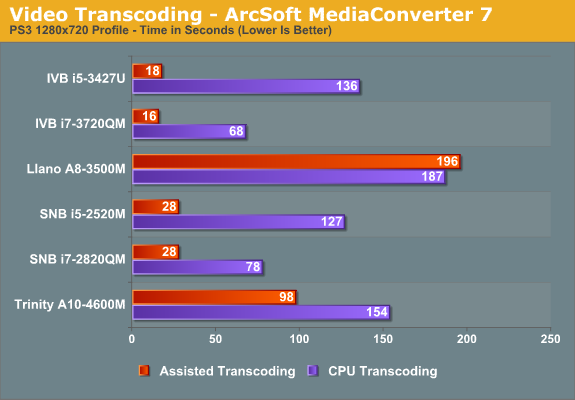
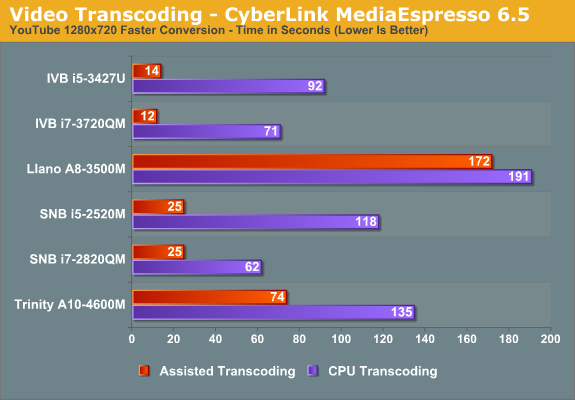
Quick Sync continues to be the undisputed champion of these two applications, beating out AMD’s accelerated transcode on Trinity by a factor of five. However, if you’re really into video transcoding and you want more control over quality, we don’t know many people who use MediaEspresso or MediaConverter. For free software, Handbrake is probably the most popular option right now, and as we showed previously, AMD has a beta OpenCL accelerated version of Handbrake that they’ve been working on where they can come very close to quad-core Ivy Bridge performance.
It remains to be seen when the public release of Handbrake will get such support, not to mention Intel and NVIDIA are going to be interested in getting the OpenCL version to run appropriately on their hardware. Still, it’s important to keep these other developments in mind. For now, the best quality transcodes still come by way of the CPU, and ULV Ivy Bridge offers better performance than AMD’s Trinity A10 in that case—never mind the standard voltage parts. We expect to see additional software companies start looking at ways to leverage OpenCL, GPUs, APUs, and Quick Sync to help with this sort of workload going forward.
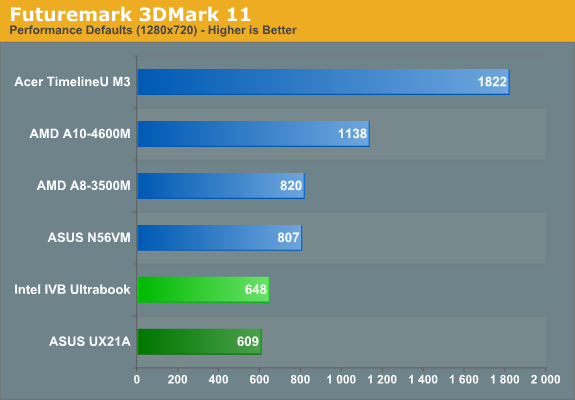
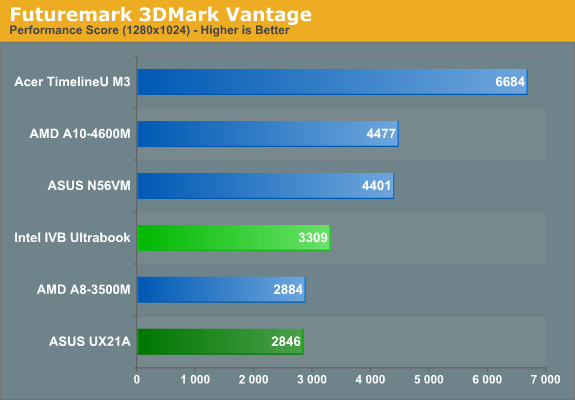
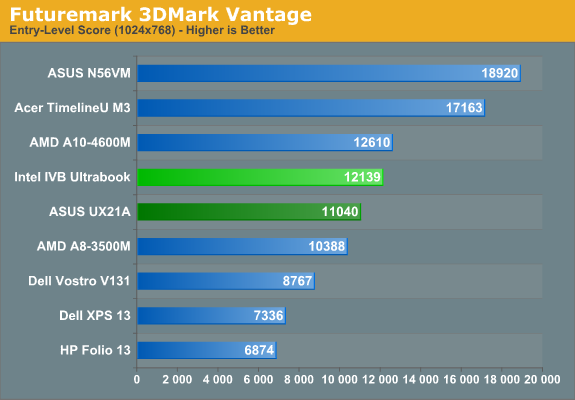
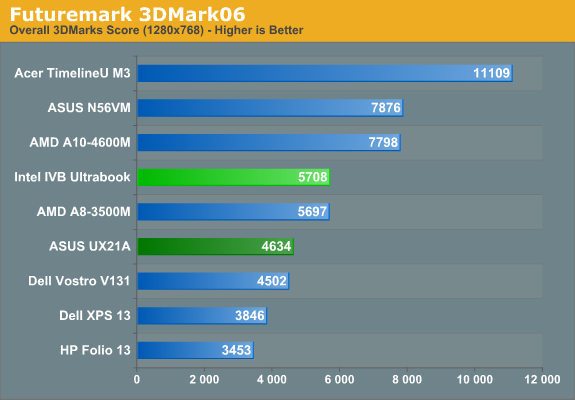
As for synthetic graphics performance, Intel has performed quite well in 3DMarks for several years now—we’d argue their 3DMark scores are often optimized far more than actual gaming performance. Still, 3DMarks are a nice way to compare across several generations of hardware, so we continue to run them on laptops. Again we see the UX21A trail the IVB ULV prototype, despite having a higher performance i7 CPU; thermal issues are the most likely cause, and the difference ranges from a rather minor 6% gap in 3DMark11 up to 23% in 3DMark06. Also interesting is that the quad-core i7-3720QM, which has a GPU that’s only clocked up to 9% higher, ends up leading the ULV IVB part by 25% (3DMark11) to as much as 33% or more! The extra—and faster—CPU cores might be a factor, but it’s also likely that the i7-3720QM is able to hit the maximum 1250MHz GPU clock far more often than the i5-3427U can hit its maximum 1150MHz clock.
Once we get beyond the Intel IGP comparisons, however, things don’t look nearly as good for ULV Ivy Bridge. Llano is around 25% faster in 3DMark11, though ULV IVB comes out ahead in the other results; Trinity on the other hand is 35-75% faster in the three main results (e.g. not counting 3DMark Vantage Entry, as that’s very low in terms of stressing the GPU). Again, the most interesting comparison is unfortunately one we can’t make yet: how will the A10-4655M 25W Trinity APU (with GPU clocks that are almost 30% lower than the 35W A10) compare with ULV IVB? We’ll have to take a wait and see approach on that one, but depending on the game it may or may not be a close matchup.










64 Comments
View All Comments
ananduser - Thursday, May 31, 2012 - link
I'm going to chicken out, out of this one :)Hector2 - Thursday, May 31, 2012 - link
Jarred is spot on. There's a mobility review on another tech website that shows how badly Llano's performance dives when fitting it into the lower TDP platform as compared to IVB.ssiu - Thursday, May 31, 2012 - link
So what is the holdup in getting 17W mobility Trinity review? Didn't AMD announce the 17W part at the same time as the 35W part? (Unlike Intel who announced the quad Ivy first, and 17W part was under NDA until now.)JarredWalton - Thursday, May 31, 2012 - link
Getting hardware. No one is shipping the LV/ULV Trinity stuff yet, and AMD didn't send out a prototype with one or both of those chips. They may not be under NDA, but they're not available for purchase anywhere that I know of.R3MF - Thursday, May 31, 2012 - link
"Given the 17W and 25W TDP on the A6-4455M and A10-4655M, they could easily fit in similar sized laptops (e.g. HP’s “Sleekbooks”). "Unfortunately HP are being utter cretins and only offering Trinity in the 15.6" Sleekbook, and not the 14" version.
WHY!
Spunjji - Thursday, May 31, 2012 - link
Because Intel, duh. :/R3MF - Thursday, May 31, 2012 - link
i'm not sure that logic applies.they allow the 15.6" Sleekbook to roll with an AMD APU.........................
but why not the 14" Envy 4!
kallogan - Thursday, May 31, 2012 - link
So ULV gpu base clocks are half of regular core i7 HD 4000. Not surprising they are not performing very well.On the cpu side it's pretty awesome. I mean Max dual core turbo is 3,0 ghz for the highest ulv cpu. I guess it's possible to run on turbo forever if the cooling system allows it. Too bad it's only BGA.
I don't know if there is 17 inches notebooks with ulv on board. Saw some 17 inch sitting at 10-15W while idling even with regular core i5. Would love a low power 17 inch.
JarredWalton - Thursday, May 31, 2012 - link
The HD 4000 ULV clocks are interesting. Base clocks are very low, but maximum clocks are quite high. WIth better cooling and configurable TDP (e.g. TDP Up or whatever it's called), it's possible there will be Ultrabooks that manage to get within 10% of the quad-core HD 4000 for graphics performance. However, Intel is only guaranteeing a rather low 350MHz iGPU clock, so in practice I bet average gaming clocks will be in the 700-900MHz range.IntelUser2000 - Thursday, May 31, 2012 - link
If there's one thing Apple is clearly ahead is managing thermals. Macbook Air's graphics performance is pretty darn close to top performance.